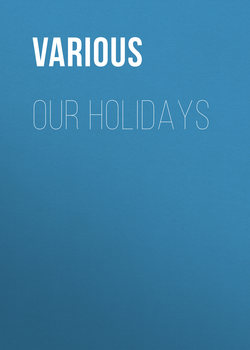Читать книгу Our Holidays - Various - Страница 3
Hallowe'en
ОглавлениеOctober 31
The Eve of All Saints' Day
This night is known in some places as Nutcrack Night, or Snapapple Night. Supernatural influences are pretended to prevail and hence all kinds of superstitions were formerly connected with it. It is now usually celebrated by children's parties, when certain special games are played.
ALL-HALLOW-EVE MYTHS
BY DAVID BROWN
As the world grows old and wise, it ceases to believe in many of its superstitions. But, although they are no longer believed in, the customs connected with them do not always die out; they often linger on through centuries, and, from having once been serious religious rites, or something real in the life of the people, they become at last mere children's plays or empty usages, often most zealously enjoyed by those who do not understand their meaning.
All-hallow Eve is now, in our country towns, a time of careless frolic, and of great bonfires, which, I hear, are still kindled on the hill-tops in some places. We also find these fires in England, Scotland, and Ireland, and from their history we learn the meaning of our celebration. Some of you may know that the early inhabitants of Great Britain, Ireland, and parts of France were known as Celts, and that their religion was directed by strange priests called Druids. Three times in the year, on the first of May, for the sowing; at the solstice, June 21st, for the ripening and turn of the year; and on the eve of November 1st, for the harvesting, those mysterious priests of the Celts, the Druids, built fires on the hill-tops in France, Britain, and Ireland, in honor of the sun. At this last festival the Druids of all the region gathered in their white robes around the stone altar or cairn on the hill-top. Here stood an emblem of the sun, and on the cairn was a sacred fire, which had been kept burning through the year. The Druids formed about the fire, and, at a signal, quenched it, while deep silence rested on the mountains and valleys. Then the new fire gleamed on the cairn, the people in the valley raised a joyous shout, and from hill-top to hill-top other fires answered the sacred flame. On this night, all hearth-fires in the region had been put out, and they were kindled with brands from the sacred fire, which was believed to guard the households through the year.
But the Druids disappeared from their sacred places, the cairns on the hill-tops became the monuments of a dead religion, and Christianity spread to the barbarous inhabitants of France and the British Islands. Yet the people still clung to their old customs, and felt much of the old awe for them. Still they built their fires on the first of May,—at the solstice in June,—and on the eve of November 1st. The church found that it could not all at once separate the people from their old ways, so it gradually turned these ways to its own use, and the harvest festival of the Druids became in the Catholic Calendar the Eve of All Saints, for that is the meaning of the name "All-hallow Eve." In the seventh century, the Pantheon, the ancient Roman temple of all the gods, was consecrated anew to the worship of the Virgin and of all holy martyrs.
By its separation from the solemn character of the Druid festival, All-hallow Eve lost much of its ancient dignity, and became the carnival-night of the year for wild, grotesque rites. As century after century passed by, it came to be spoken of as the time when the magic powers, with which the peasantry, all the world over, filled the wastes and ruins, were supposed to swarm abroad to help or injure men. It was the time when those first dwellers in every land, the fairies, were said to come out from their grots and lurking-places; and in the darkness of the forests and the shadows of old ruins, witches and goblins gathered. In course of time, the hallowing fire came to be considered a protection against these malicious powers. It was a custom in the seventeenth century for the master of a family to carry a lighted torch of straw around his fields, to protect them from evil influence through the year, and as he went he chanted an invocation to the fire. The chief thing which we seek to impress upon your minds in connection with All-hallow Eve is that its curious customs show how no generation of men is altogether separated from earlier generations. Far as we think we are from our uncivilized ancestors, much of what they did and thought has come into our doing and thinking,—with many changes perhaps, under different religious forms, and sometimes in jest where they were in earnest. Still, these customs and observances (of which All-hallow Eve is only one) may be called the piers, upon which rests a bridge that spans the wide past between us and the generations that have gone before.
